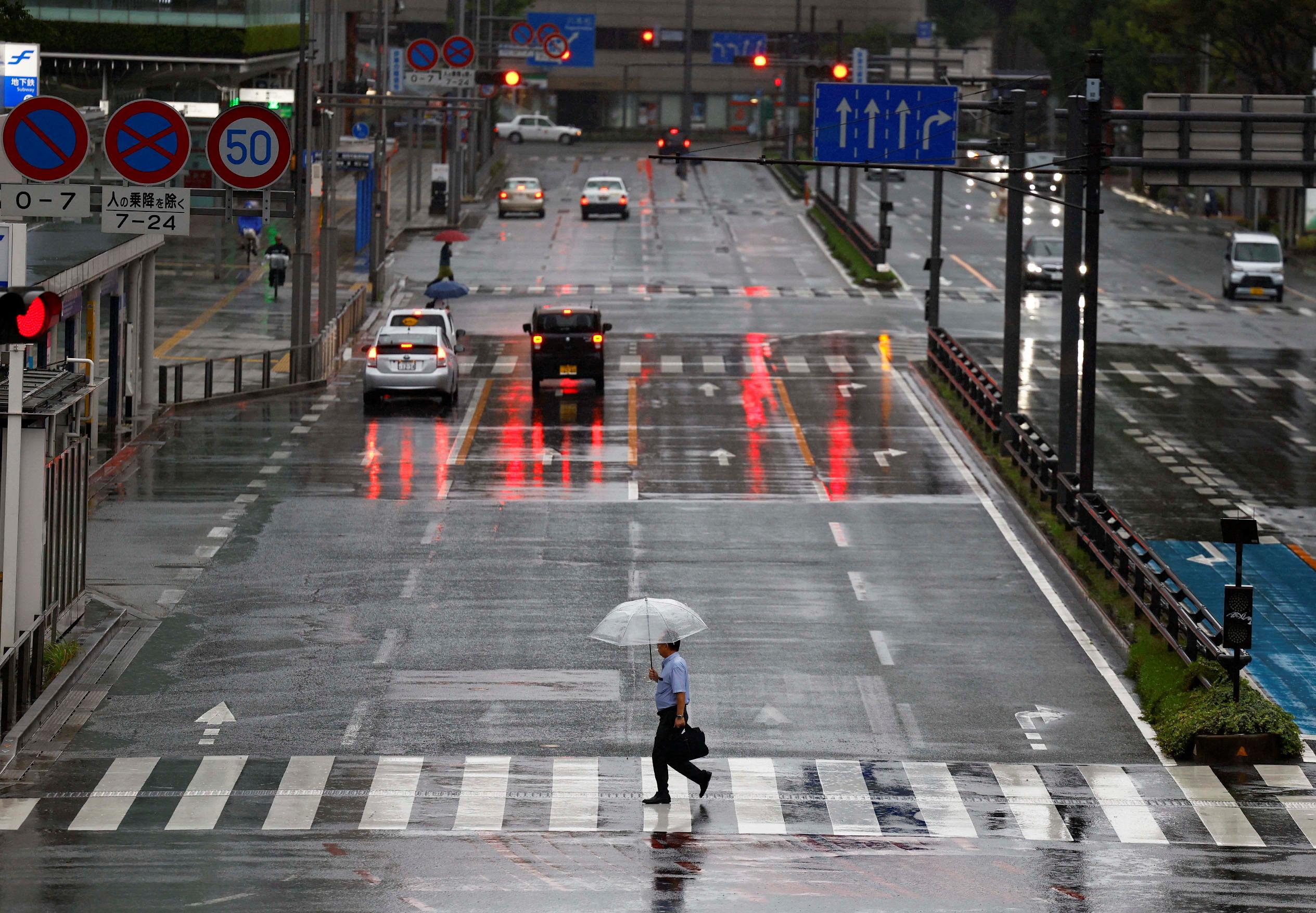
2024-08-30 04:41
SEOUL, Aug 30 (Reuters) - South Korea said on Friday it aims to ensure all departing international flights use a mix of about 1% of sustainable aviation fuel (SAF) from 2027. The step aims to prepare for a carbon offset , opens new tab and reduction scheme that becomes mandatory for members of the International Civil Aviation Organization (ICAO) starting from that year, the industry and transport ministries said. "As the world's No. 1 exporter of aviation fuel, South Korea needs bold policy support to prepare for the SAF market as a promising new growth engine in response to global demand expansion," they said in a statement. Six South Korean airlines, including flag carrier Korean Air (003490.KS) , opens new tab, have begun, or plan, to mix 1% of SAF in the fuel for a single international route once a week starting from this year, the ministries added. SAF, an alternative to petroleum jet fuel, is produced from agricultural and waste feedstocks. Demand for SAF is expected to grow to 18.35 million tonnes in 2030 from 240,000 tonnes in 2022, the ministries said, citing data from the International Air Transport Association (IATA). For the oil refining industry, the government said it is reviewing wider tax breaks for investment in developing SAF, as well as incentives to ease the burden of high SAF production costs in future. Sign up here. https://www.reuters.com/business/energy/south-korea-plans-mix-sustainable-aviation-fuel-international-flights-2027-2024-08-30/

2024-08-30 04:41
CANBERRA, Aug 30 (Reuters) - Australia's almond plantations grew by 3% last year, an industry association said on Friday, as concerns about rising production costs and the availability of water weigh on an industry that boomed in the last two decades. The area of Australia covered by almond trees rocketed from just 3,500 hectares (8,649 acres) in the year 2000 to almost 60,000 hectares two decades later, turning the country into the world's second-largest producer after the United States. But growth has since slowed sharply, with a mix of removals and new plantings lifting the total area under cultivation to 64,192 hectares by the end of 2023, up 1,778 hectares from the prior year, the Almond Board of Australia said in a report. The industry has experienced a difficult few years of falling almond prices, too-plentiful rainfall that stunted yields and the arrival of a bee parasite, varroa mite, complicating pollination. In addition, there are mounting fears that water will become costlier as the government restricts the amount of river water available to agriculture in southeast Australia to what it says are more sustainable levels. Almond Board CEO Tim Jackson said higher costs of production, low returns and uncertainty around longer-term water use had slowed the industry's expansion. "The decade long planting boom that has resulted in the industry more than doubling in size has levelled off as existing growers and potential investors take stock," he said. Australia exported 106,599 metric tons of almonds in the 2023/24 season worth nearly $500 million, with around half going to China and India, the Almond Board said. About 1.5 million tons of almonds are produced globally each year, nearly four-fifths of them in California. Sign up here. https://www.reuters.com/markets/commodities/australias-almond-plantations-eke-out-slow-growth-amid-water-worries-2024-08-30/

2024-08-30 04:36
A look at the day ahead in European and global markets from Rae Wee Global investors can't wait to be done and dusted with August and usher in the new month with a bang, one that's all but certain to kick off a long-awaited Federal Reserve easing cycle. Asia shares rose on Friday and are poised for a solid end to the month, while the dollar was headed for its worst monthly performance since last November, after Fed policymakers over the past week or so essentially gave the green light for a rate cut on Sept. 18. U.S. stock futures also extended Wall Street's positive run, while European futures were mixed. The sell-off of Aug. 5, when fears suddenly emerged of an imminent U.S. recession, has faded into a distant memory. Those fears have since fizzled, and order has returned to the markets. The last trading day of the month marks a busy day for Europe, where investors will pore over UK house prices, a data dump from Germany running the gamut from retail sales to unemployment to import prices, and French producer and consumer prices. That's followed by figures on euro zone inflation, which are expected to show consumer prices slowing to an annual 2.2% in August, from July's 2.6%. But after preliminary German inflation data on Thursday showed a greater-than-expected decline for this month, the reading for the wider bloc could render a downside surprise. European Central Bank (ECB) policymakers have been circumspect about their next move at the upcoming September meeting, with some wary about lowering interest rates too quickly. But traders have already fully priced in a rate cut. Should Friday's euro zone inflation number come in below expectations, and with the Fed looking set to start lowering rates soon, the ECB would have little room to push back against market expectations for easing. Over in the U.S., the release later today of the core personal consumption expenditures (PCE) price index - the Fed's preferred measure of inflation - headlines a week that's otherwise been lacking in market-moving data. However, the bigger focus will likely be on next week's nonfarm payrolls report, given the Fed's focus on the health and state of the U.S. labour market. Upcoming employment numbers are set to shape how far and fast the Fed would have to cut rates to prevent what Fed chief Powell warned could be an "unwelcome further weakening in labour market conditions", and will determine whether the market is justified in pricing for 100 basis points of easing this year. In Asia, data on Friday showed core inflation in Tokyo accelerated for a fourth straight month in August, likely giving the Bank of Japan (BOJ) another reason to hike rates in the coming months. Key developments that could influence markets on Friday: - Germany retail sales, import prices, unemployment rate - France producer prices (July) - UK house prices (August) - France, euro zone CPI (August) - Euro zone unemployment rate (July) - US PCE price index (July) Sign up here. https://www.reuters.com/markets/europe/global-markets-view-europe-2024-08-30/

2024-08-30 04:22
OPEC+ to proceed with planned oil output hike from October U.S. consumer spending data dampens hopes for hefty Fed rate cut Libya's oilfield closures cause significant production losses HOUSTON, Aug 30 (Reuters) - Oil prices retreated on Friday as investors weighed expectations of a rise in OPEC+ supply starting in October, alongside dwindling hopes of a hefty U.S. interest rate cut next month, following data showing strong consumer spending. Brent crude futures for October delivery , which expire on Friday, settled $1.14 lower, or 1.43%, at $78.80 a barrel, marking a decline of 0.3% for the week and 2.4% for the month. U.S. West Texas Intermediate crude futures settled down $2.36, or 3.11%, to $73.55, a drop of 1.7% in the week and a 3.6% decline in August. The Organization of the Petroleum Exporting Countries and allies, known as OPEC+, is set to proceed with a planned oil output hike from October, as the Libyan outages and pledged cuts by some members to compensate for overproduction counter the impact of sluggish demand, six sources from the producer group told Reuters. "OPEC+ talking about going ahead with tapering off production cuts was the headline that really sunk us today," said Phil Flynn, analyst with Price Futures Group. Meanwhile, investors responded to new data that showed U.S. consumer spending increased solidly in July, suggesting the economy remained on firmer ground early in the third quarter and arguing against a half-percentage-point interest rate cut from the Federal Reserve next month. Lower rates can boost economic growth and demand for oil. "That modest inflation increase could basically solidify that we will only get a quarter percentage-point cut and those hoping for a half will have to wait," said Price Futures Group's Flynn. Elsewhere, Libya's National Oil Corporation said recent oilfield closures have caused the loss of approximately 63% of the country's total oil production, as a conflict between rival eastern and western factions continues. Production losses could reach between 900,000 and 1 million barrels per day (bpd) and last for several weeks, according to consulting firm Rapidan Energy Group. Libya's eastern-based government announced the closure of all oil fields on Monday, halting production and exports and driving oil to settle at a near-two week high on Aug. 26. "It is interesting see the shutdown of Libya's crude oil production have such an impact on market prices one day and completely ignored the next," said Tim Snyder, chief economist at Matador Economics. “It looks to me right now there is a lot of negative inertia in the market pulling prices down,” Snyder added. Iraqi supplies are also expected to shrink after the country's output surpassed its OPEC+ quota, a source with direct knowledge of the matter told Reuters on Thursday. Iraq plans to reduce its oil output to between 3.85 million and 3.9 million bpd next month. In the U.S., the number of active oil rigs , opens new tab was unchanged at 483 this week, but rose by one in August, Baker Hughes said. Sign up here. https://www.reuters.com/business/energy/oil-steady-players-take-stock-middle-east-supply-concerns-2024-08-30/

2024-08-30 00:37
Indian economy seen expanding 6.9% y/y in April-June qtr - poll GDP data to be released on Friday 1200 GMT Economists see economic growth momentum remaining robust NEW DELHI, Aug 30 (Reuters) - India's economic growth is expected to have slowed in the April-June quarter due to reduced government spending during the national elections and stalling consumption. A Reuters poll of 52 economists projected GDP growth of 6.9% year-on-year for the three months through June, the first quarter of India's 2024/25 fiscal year. That is below the central bank's estimate of 7.1% and the 7.8% growth rate of the previous quarter. If the projection holds, India will remain the world's fastest growing major economy. Official GDP growth figures for recent quarters have consistently exceeded forecasts. For the full fiscal year, the central bank expects the economy to grow 7.2%, slower than 8.2% growth the previous year, dragged down by a contraction in state spending and the central bank's tightened rules on retail loans. The government is due to announce GDP figures for the April-June quarter on Friday at 1200 GMT. Garima Kapoor, an economist at Elara Capital, said uncertainty surrounding the general elections negatively affected infrastructure and capital expenditure in the June quarter, but economic activity was recovering. "Our real sector indices continue to signal a steady and healthy economy, led by consumption." Government spending in the June quarter fell 7.7% on year, compared with a 10.8% increase during the same period a year earlier, she said. Political uncertainty also weighed on investment and consumption during the April-June quarter, Mumbai-based brokerage Axis Capital said in a note. After a setback in the general election, Prime Minister Narendra Modi increased spending with a $576 billion annual budget. The budget included billions of dollars for affordable housing and rural jobs, aimed at boosting the economy. Economists expect that favourable rainfall this year will enhance farm output, rural incomes, and consumer demand, a trend reflected in the increased sales of two-wheelers and tractors in July. "At this stage, this weakness would be attributed to election-related uncertainty and slowdown in government spending," Axis Capital said. "However, if growth momentum does not improve in the next few months, the annual growth forecast of 7% could be at risk." However, economists warned that a tight monetary policy could also constrain growth. Earlier this month, the Reserve Bank of India (RBI) maintained its policy rate, focusing on sustainably reducing inflation towards its 4% medium-term target. Despite strong growth relative to other economies, India is lagging on job creation and more inclusive economic growth, which has weighed on wages and consumption of lower income households as well as investments by private companies. "It will take India 75 years to reach one-quarter of U.S. per capita," said a World Bank report , opens new tab released earlier this month, adding "with growing demographic, ecological and geopolitical pressures, there is no room for error." Sign up here. https://www.reuters.com/markets/asia/indias-june-qtr-gdp-growth-likely-slowed-reduced-government-spending-2024-08-30/

2024-08-30 00:35
4 dead, 99 injured as storm rumbles eastwards More than 4 mln people told to evacuate Record rainfall seen far from storm centre Toyota shuts all Japan plants through Monday FUKUOKA/YUFU, Japan, Aug 30 (Reuters) - Typhoon Shanshan soaked large swathes of Japan with torrential rain on Friday, prompting warnings for flooding and landslides hundreds of miles from the storm's centre, halting travel services and shutting production at major factories. At least four people have been killed and 99 injured in storm-related incidents in recent days, according to the disaster management agency. In the southwestern region of Kyushu, where the storm that authorities say could be one of the strongest ever to hit the region made landfall on Thursday, residents were surveying the damage after a night of heavy rain and severe winds. Yu Fukuda, 67, who runs a fish farm and adjoining restaurant in the resort town of Yufu in Oita prefecture said she arrived on Friday morning to find flood waters one-metre (3 ft) high had inundated the building. "There were streaks on the windows and everywhere there were marks from mud and dirt, so I could tell how high the water had risen. I felt very sad," she told Reuters as her staff and relatives cleared the debris of fishing nets and dead fish. "I wish the typhoon had just passed quickly, but it stayed around here for a long time," she said. Bringing gusts of up to 50 metres per second (180 km per hour/112 mph), strong enough to blow over moving trucks, the typhoon was near the coastal city of Matsuyama in Ehime Prefecture at 3:45 p.m. (2345 GMT) and moving east, according to authorities. Around 250,000 households in seven prefectures were without power in Kyushu on Thursday, according to Kyushu Electric Power Co., but many had seen services restored on Friday. The warm and moist air flowing around the typhoon brought record-breaking levels of rain in some areas far from the main storm, which authorities say is concerning given its slower than expected movement across the country. Notices advising residents to evacuate have been issued to more than 3.3 million people nationwide, mostly in the hard-hit Kyushu area and central and eastern regions including the capital Tokyo and nearby Yokohama. Authorities there warned of possible landslides and rivers bursting their banks due to the heavy rain. Shizuoka, a major city in central Japan, has seen more than 500 millimetres of rain in the last 72 hours, the highest volume since the weather agency began collecting the data in 1976. But, as of Thursday, only some 30,000 had been evacuated, mainly in Kyushu, disaster management minister Yoshifumi Matsumura said. The storm is expected to approach the central and eastern regions, which includes Tokyo, at the weekend and into early next week, the weather agency said. Toyota (7203.T) , opens new tab has suspended operations in all of its domestic plants through Monday morning due to the storm. Other automakers Nissan (7201.T) , opens new tab and Honda (7267.T) , opens new tab, semiconductor firms Renesas (6723.T) , opens new tab and Tokyo Electron (8035.T) , opens new tab, and electronics giant Sony have also temporarily halted production at some factories. Airlines, including ANA Holdings (9202.T) , opens new tab and Japan Airlines (9201.T) , opens new tab, have announced cancellations of hundreds of domestic and some international flights. Many ferry and rail services, including the bullet train between Tokyo and the central city of Nagoya, were suspended on Friday morning. Lin Yue-Hua, a 60-year-old tourist from Taiwan, had her flight from Fukuoka back home cancelled on Thursday. She was told to book another flight but was struggling to make her way to the airport on Friday morning. "We were very worried and upset because we didn’t know what to do," she told Reuters at a near-deserted train station on Friday morning after finding out that all rail services, including the subway to the airport, had been cancelled. "We stayed one more day in Japan. Then we saw it in the news that our flight from Taiwan couldn’t land in Japan after flying around the area for about 40 minutes and it flew back to Taiwan. We have been busy trying to find our way home," she said. Typhoon Shanshan is the latest harsh weather system to hit Japan, following Typhoon Ampil, which also led to blackouts and evacuations, earlier this month. Sign up here. https://www.reuters.com/world/asia-pacific/typhoon-shanshan-pounds-japan-with-torrential-rains-severe-wind-2024-08-30/
